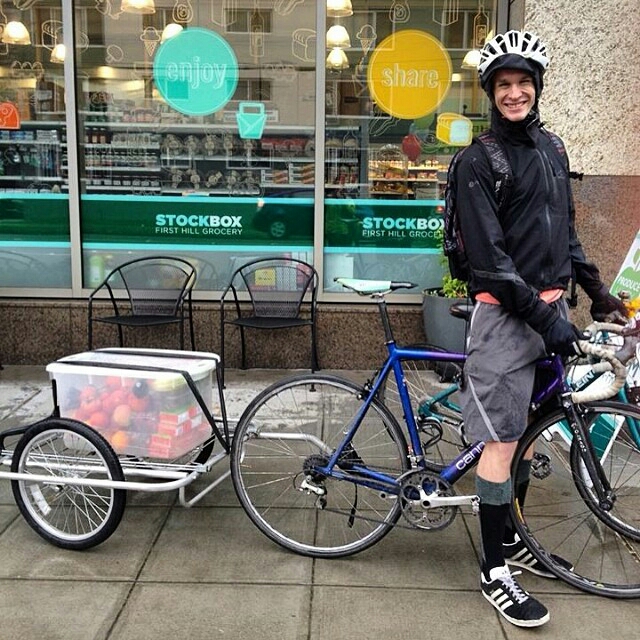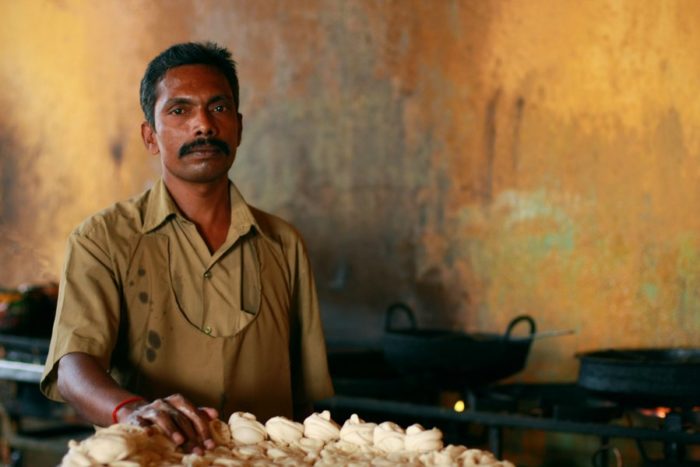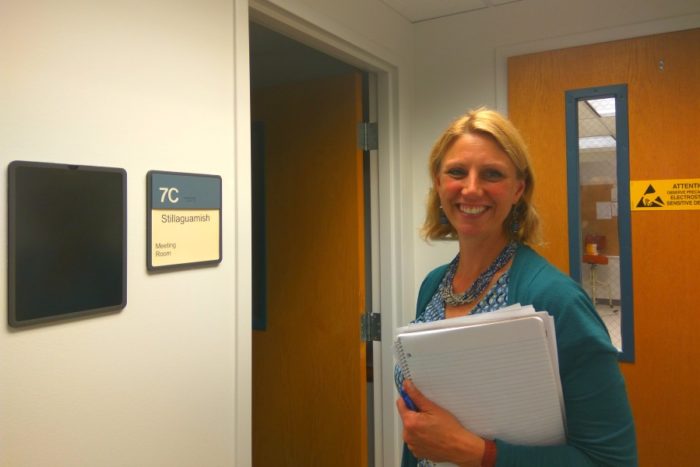
Meet Tim.
He cycles around Seattle, distributing food to kitchens and lower income households in Seattle.
Tim saves food.
Instead of throwing it away, or composting unwanted food, the Seattle Food Rescue has created a small network, linking the needy and the privileged. Inspired by the Boulder Food Rescue, which used bicycle power to recover over half a million pounds of food, Tim, a long way from Colorado, decided to expand the revolution. Their unique model involves bicycles, as opposed to cars that may cause obstacles in a constricted space like Seattle. The Bike Redistribution Model works well. The pickup and drop off locations being paced a mile apart; this ergonomic design was set in place two years ago; drawing in massive amounts of volunteers from UW.
And changing the lives of hundreds.
I met Tim on a dreary Seattle morning. Dressed in smart office wear, on the way to his job at a software company, he showed no signs of Monday blues. Our conversation revealed that he was a man highly concerned about the problem of food wastage, and is indeed the man to tackle the issue, ‘Food wastage is an unnecessary evil. One of the benefits of targeting food waste is that it solves two separate problems – wasting food that is otherwise edible and also, having the other effect i.e. feeding people who could use it. If you consider the agricultural system in America, there is a significant amount of food waste before it gets to the supermarket. Then from the supermarket there is waste, from the supermarket to the consumer; then the consumer also wastes food – there’s all these tiers. An awareness of all these problems makes it easier to tackle it systemically.’
Hundreds of students zip across the roads of Seattle, carrying baskets of food. Tim, with a gleam in his eye observes, ‘Food rescue is such a tangible concept, where you’re physically picking up food and bring it to another individual to use it, it certainly is tremendously impactful and very personal.’
At the dawn of the 21st century, the world saw countries developing at the speed of light. The food scarce years post the wars and the Great Depression lingered at the back of our minds, a boogieman repressed as we saw dreams of economic stability come true. 15 years later, we landed back on square one.
The numbers are startling. The USA wasted over 37 million tons of food waste in 2013. While on the side of the globe, India faces startling levels of food scarcity. Though the government has put up measures to combat the problem, the situation remains bleak. Jean Drèze, development economist remarks, ‘The National Food Security Act (NFSA) has demonstrated, in a number of states, its ability to protect most people from hunger and contribute to their economic security. But most states are yet to achieve effective implementation of the Act. And some aspects of the Act, like maternity entitlements, have been brazenly ignored throughout the country.’ Recently having conducted a survey across the poorest states in India, the detailed report tracked the effectiveness of the PDS system.

At middle class homes in Delhi, such as mine, most households which have maids, servants or helpers cooking, have kept the khatirdari and dil alive by a simple gesture for the ‘bai’, ‘didi’, ‘bua’, ‘kaka’ or ‘mai‘. Each time a meal is cooked, the helper takes home his/her share. In Bangladesh, maids and servants are in high demand during Eid where preparing iftar after the day’s fasting requires help. Since it is cooked after sunset, the helpers take back the iftar for their families. Sri Lankan, Nepali and Mexican households do the same. Often from poorer backgrounds, the helpers have little to no education. They migrate to the big cities, in search for jobs, abandoning their farm lands – only to find that the streets being lined with gold is a myth. As they work in middle class and rich households, they are treated with various levels of kindness and indifference. Many a child has grown up with the aya being an integral part of their lives – by virtue of taking care of them; a second mother. Grandmothers (Nanima) rely on them to make the complex khaana perfect, by ensuring that the ingredients of the tadka – from the sun dried chillies to the fresh veggies from the sabzi mandi, to the best ghee arrives on time. In the kitchen, evening chai is made over gossip, and had over gossip on the porch – with members of two different levels of social strata. There has been a conscious effort on the level of societal norms, to bridge the gap between the rich and the poor. This act kills two birds with one stone – Decreases social stigma regarding monetary insecurity and reduces food wastage generated in residential areas. It is a curious phenomenon in a world located far from the ‘developed’ countries. The sense of community is much needed in a while that insists on fragmentation and individual isolation whilst emphasizing on monetary gains.
12,000 kms away, the citizens of Washington and their representatives, have chosen to take the first step towards making a change.

I tracked down Dawn Marie Maurer, solid waste regulatory specialist at the Department of Ecology, to shed some light on the situation. She does so, in manner as one recites a story, ‘Once upon a time when Seattle was small, we had a lot of landfills around the city itself. Those landfills were usually in a swamp or some other low lying area – Seattle is actually riddled with hundred-year-old landfills; long long ago closed, and have not been used. Seattle has changed. It now has a ban on food waste disposal. Prior to the ban going into becoming effective, the food waste will go into any other kind of garbage and it would go through this system. Now there is a requirement to separate out your food waste.’
People are the machinery in the clockwork that makes these organizations tick. Christine Benson, co-author of the Food Waste Prevention and Recovery Assessment Report which was prepared for Seattle Public Utilities emphasizes, ‘If you going to do food based policies, you’ll have a lot of people involved who’ll affect the anti-hunger organization, the donor businesses, the agencies that are enforcing the work.’ The report highlights the problems that the system has, along with exhaustive suggestions as to refine it, ‘We tried to get information about the concerns, the barriers, the challenges, the successes, the recommendations of all the sectors related to food waste policy and that enabled us to make suggestions to the city of Seattle that were taking into account the experiences of all those different sectors.’
An amalgamation of various agencies has taken it up to combat food wastage ranging from recovery to discovery. It is the recognition of the fact that access to food is a privilege determined by factors beyond an individual’s control. That hunger is a pervasive issue, which every being can understand. Empathy for fellow humans, and an awareness of one’s actions has enabled the functioning of such systems to work relatively smoothly. In the new age, you, the reader has the ability to reach out, to any one of such organizations to make a massive difference to a family. Filling an empty stomach with your leftover food, can change lives. And it is time, to extend the helping hand.
It is time.
This story was produced by a student in the “Study of the U.S. Institute (SUSI)” program, a collaboration between The Seattle Globalist and FIUTS, supported by the U.S. Department of State. The program brings 20 undergraduates from Sri Lanka, India, Bangladesh and Nepal to Seattle. Participants study journalism and new media, and participate in volunteer and service activities, leadership workshops, and cultural excursions. The story is an example of student work and has not yet been through the Seattle Globalist’s standard editing and fact-checking process.

